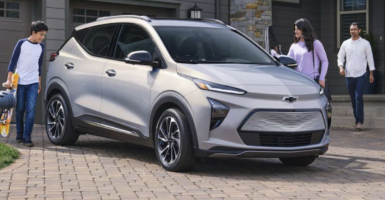Solar-Powered Cars Poised To Replace Electric Ones?
Solar-powered cars are not yet available in the United States, but in the future, they could serve as fantastic sustainable transportation alternatives for those living in regions without developed charging infrastructure.
This article is more than 2 years old
There’s a big demand for sustainable vehicles these days, and electric cars have another contender in the quest to produce the most environmentally friendly ride. Solar-powered cars use technology that converts sunlight into usable energy. This free power source is a clear advantage for people who live in regions where electric vehicle charging infrastructure is underdeveloped.
Solar-powered cars are defined as electric vehicles that are powered fully or partly by direct solar energy. The batteries in EVs can store solar power which is obtained through a variety of photovoltaic cells that convert solar radiation into usable electric power. These cells get their name from sunlight (photons) and electricity (voltage) and are grouped into panels to produce small or large amounts of energy.
According to green design and lifestyle site InHabitat, the solar power industry is one of the fastest-growing industries in the United States. Solar power is free, provided that your region of the country receives enough direct sunlight each day. It’s already being used in solar-powered cars, and many electric vehicle charging stations could benefit from installing solar panels.
Solar-powered cars share the significant advantages of electric vehicles, including near-silent engines and zero emissions. They can be charged at home or at charging stations like other EVs, but using a portable solar battery maintainer can lengthen the time between charging sessions. This is especially true if you drive often during the day and experience ample sunny weather.
Totally solar-powered cars are not yet a reality in the United States. However, many of the partially solar-powered vehicles available today are making good progress toward a future filled with cars running solely on sunshine. Some of the best solar-powered cars on the market include the Lightyear One Solar EV, which has five square meters of solar panels mounted on its roof and hood, and Germany’s Sono Motors’ Sion.
In China, a company called Hanergy showcased their new solely solar-powered car earlier this year at the sixth annual World Intelligence Conference. The four-seater Tianjin solar vehicle features 47 advanced technologies including autonomous driving. It can run nearly 50 miles on one charge, at a max speed of 49 miles per hour.

Toyota has also worked on producing solar-powered cars, stating in 2019 that it was in the testing stages of a solar-powered Prius. In July 2022, the company revealed the “extremely limited” bZ4X that includes a solar panel roof. The bZ4X meets the EPA standard of 252 miles per charge and can reach a top speed of 100 miles per hour.
The main problem with nearly all solar-powered cars is that they are limited by climate and cannot generate enough power to run on the sun alone. They are not practical for people who do most of their driving at night unless they’re parked in a lot that offers EV charging. Solar-powered vehicles may one day become more common than regular electric vehicles, but the technology to mass-produce them remains a distant dream for the environmentally mindful traveler.







